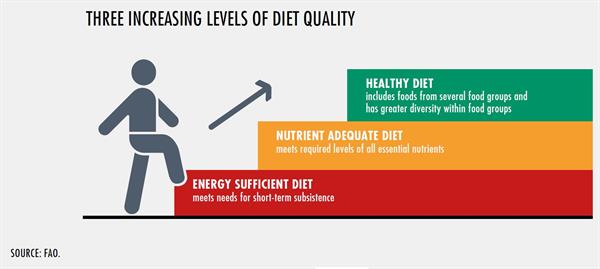Optimizing Nutrition Across the Lifespan: Why Improving Diet Quality is Critical
.png?sfvrsn=5f9285e4_4)
By: Kristal Shelden, MPH, RDN and Ashley Rosales, RDN
We would like to thank Kristin Hirahatake, PhD, RD for providing third-party review of this issue.
Rates of chronic diseases have risen dramatically over the last two decades, in part because of the advances in the food system, including the focus on large-scale production of calorie-dense, highly processed food.1 In response, the field of nutrition science has evolved in order to meet these new health challenges faced by the public, shifting to harness the health-promoting aspects of whole foods and overall diet quality. Scientific evidence has consistently demonstrated the important role of healthy eating patterns in addressing chronic diseases such as heart disease, type 2 diabetes and cancer.2
Scientific evidence has consistently demonstrated the important role of healthy eating patterns in addressing chronic diseases such as heart disease, type 2 diabetes and cancer.
 Nutrition
guidance is expanding beyond individual nutrients to overall diet quality, addressing the unique needs of each life stage. Nutrition science is a relatively new field of research, and as with any science, it is evolving. In the first half of the twentieth
century, nutrition science was defined by the discoveries of vitamins and minerals and their role in nutrient deficiencies and related diseases. These discoveries led to fortified foods, providing a solution to correct and prevent future nutrient
deficiencies. Examples include adding vitamin D to milk and iodine to salt, or fortifying grains with folic acid. After the Great Depression and World War II, the food system evolved to mass production of inexpensive, shelf-stable and nutrient-fortified
foods. Progressions in nutrition science and food technology during that time had positive impacts on some global public health issues, including reducing hunger and vitamin deficiency.3 However, today the American
and global populations face different health issues in need of new solutions.
Nutrition
guidance is expanding beyond individual nutrients to overall diet quality, addressing the unique needs of each life stage. Nutrition science is a relatively new field of research, and as with any science, it is evolving. In the first half of the twentieth
century, nutrition science was defined by the discoveries of vitamins and minerals and their role in nutrient deficiencies and related diseases. These discoveries led to fortified foods, providing a solution to correct and prevent future nutrient
deficiencies. Examples include adding vitamin D to milk and iodine to salt, or fortifying grains with folic acid. After the Great Depression and World War II, the food system evolved to mass production of inexpensive, shelf-stable and nutrient-fortified
foods. Progressions in nutrition science and food technology during that time had positive impacts on some global public health issues, including reducing hunger and vitamin deficiency.3 However, today the American
and global populations face different health issues in need of new solutions.
As recently highlighted in the Dietary Guidelines for Americans, poor-quality dietary patterns are associated with negative health outcomes and chronic diseases that an increasing number of Americans face. With an increase in food insecurity in America and globally, marginalized communities are disproportionately affected by these consequences.4,5 In addition to reducing quality of life, diet-related diseases burden the health care system, widen the academic achievement gap and even hurt the economy through loss of productivity in the workforce. These inequities are further exacerbated by systemic issues of poverty, racism and other socioeconomic barriers.
Building a more resilient, equitable and sustainable food system is one of the urgent calls of this generation.
Solving the interrelated public health crises of poor-quality diets and increasing obesity and health disparities, as well as reducing the strain to the planet’s natural resources, will all rely on effective changes to the food system.6 Building a more resilient, equitable and sustainable food system is one of the urgent calls of this generation.
Nutrition research and public guidance are shifting their focus from the general, healthy adult population to dietary patterns within and across life stages. Each life stage, from birth to older adulthood, requires distinct guidance to meet the unique nutritional and health needs of that stage. During critical life stages such as pregnancy, infancy, childhood and adolescence, nutrient-dense foods make an important contribution to eating patterns, supporting proper brain development and promoting lean muscle development, bone health, normal growth and healthy weight.7
During critical life stages such as pregnancy, infancy, childhood and adolescence, nutrient-dense foods make an important contribution to eating patterns, supporting proper brain development and promoting lean muscle development, bone health, normal growth and healthy weight.

Nutrient-dense, high-quality foods include milk, yogurt, cheese, vegetables, fruits, whole grains, beans, nuts, seeds, fish, lean meat, poultry, eggs and healthy fats and oils. Dietary patterns that include these protective foods as a foundation for healthy
eating support optimal health for all populations.8 Once these healthy eating patterns are established, they can be carried throughout the lifespan.
One foundational life stage begins at birth. Nutrition fuels brain growth and development from the start. It lays the foundation for cognitive abilities, motor skills and socio-emotional development, which in turn profoundly influence success in school and economic opportunities later in life. But according to a UNICEF report, 59% of children worldwide are not being fed the much-needed nutrients that can be provided by high-quality animal source foods, and 44% of children worldwide are not fed any fruits or vegetables.9 These facts emphasize that the availability and accessibility of high-quality nutrient-dense foods, from both plant and animal sources, are important for children’s growth, development and overall health.
Nutrition fuels brain growth and development from the start.
Dietary guidelines aim to be seen not as prescriptive but rather as flexible and applied to an individual’s life stage, while focusing on how foods can meet nutritional needs. This shift is notably addressed in the new edition of the 2020–2025 Dietary Guidelines for Americans. The latest Dietary Guidelines recommend eating patterns for key life stages, including pregnant and lactating women and children from birth to 24 months. It also identifies underconsumed nutrients that pose a public health concern specific to the needs of these populations, such as iodine and choline for pregnant and lactating women, iron for infants and phosphorus for adolescents, among others. Calcium, vitamin D, potassium and dietary fiber remain nutrients of concern for all age groups.8 The lens of applying nutrition guidance to meet the important needs of critical life stages will continue to shape nutrition research for the coming years, as evidence will build on the understanding of food quality and dietary patterns across the life span.
Over the past few decades, the food environment has changed dramatically, widening the gap of healthy food consumption, especially in more disadvantaged populations. The obesity epidemic that has emerged over the decades mirrors these changes in the food
environment. Poor-quality diets have devastating impacts, resulting in about 11 million deaths per year around the world.2 Most risk factors for high-burden diseases are linked to dietary eating patterns.1846e605d655458c947fbc27fb9f2cb2.png?sfvrsn=3ea7ef4a_8&MaxWidth=500&MaxHeight=350&ScaleUp=false&Quality=High&Method=ResizeFitToAreaArguments&Signature=49E92D6ACE5A518D5D7445954007932796A85DDD) It
is also important to acknowledge the American experience with access to food, particularly in the context of the ongoing COVID-19 pandemic. In the spring of 2020, Feeding America provided a report and analysis of food insecurity in the US population
due to the impact of COVID-19. The report observed that households with children are more likely to be food insecure, and the consequences of the pandemic, including rising unemployment and child poverty, would result in 18 million (1 in 4) children
experiencing food insecurity. In line with being the most populous state, California, is expected to see the largest increase in the number of people experiencing food insecurity (2.1 million), as well as the largest total number of people experiencing
food insecurity (6.4 million).10
It
is also important to acknowledge the American experience with access to food, particularly in the context of the ongoing COVID-19 pandemic. In the spring of 2020, Feeding America provided a report and analysis of food insecurity in the US population
due to the impact of COVID-19. The report observed that households with children are more likely to be food insecure, and the consequences of the pandemic, including rising unemployment and child poverty, would result in 18 million (1 in 4) children
experiencing food insecurity. In line with being the most populous state, California, is expected to see the largest increase in the number of people experiencing food insecurity (2.1 million), as well as the largest total number of people experiencing
food insecurity (6.4 million).10
Food insecurity is more than just experiencing hunger. Food insecurity, from moderate to severe, is tied to poor-quality diets. Access, availability and costs of healthy foods can lead food-insecure families to compromise on diet quality. This may lead to numerous health issues such as undernutrition, including nutrient deficiencies; impaired immune function; and overweight, obesity and other chronic diseases.5
Food insecurity is more than just experiencing hunger.
The interrelated issues of food insecurity, undernutrition, and overweight and obesity form the concept of the triple burden of malnutrition.9 The coexistence of these issues highlights the importance of addressing diet quality in conjunction with food insecurity. The current food environment does not enable people to make healthy food choices and worsens diet-related disparities, including the accessibility of fresh foods and targeted marketing of calorie-dense, nutrient-poor foods to marginalized communities. 11 The availability of dietary energy in the form of calorie-dense foods has increased throughout the world but has not translated to availability of high-quality foods. According to the Food and Agriculture Organization of the United Nations, “Studies from different countries have shown that both dietary diversity and consumption of nutritious foods, such as fruits, vegetables, dairy and meat, tend to worsen as food insecurity becomes more severe.” 5 Solutions aimed at food insecurity need to focus on access and affordability of high-quality, culturally acceptable, nutrient-dense foods that make up a healthy eating pattern and are protective against the triple burden of malnutrition.
Not all foods within the food groups are created equal. When discussing the quality of foods, comparisons of nutrients against nutrients cannot be made. Foods contain complex structures of nutrients and other bioactive compounds that can be modified with
differing levels of processing such as cooking, fermenting, preserving or refining. Food processing is a centuries-old practice that helps ensure food safety and freshness. In some instances, processing can even enhance the nutrition of a food. For
example, fermenting dairy milk creates probiotic-rich yogurt, and cooking tomatoes may help protect the body from cancer by increasing the content of lycopene, an antioxidant.12 However, highly processed or ultraprocessed
foods are highly refined, resulting in a loss of important nutrients such as fiber and vitamins, and they offer little nutritional value. Examples are potato chips, packaged desserts and sugar-sweetened beverages, such as soda or energy drinks. Researchers
are further drawing attention to hyperpalatable foods, characterized by combinations of fat, sugar, sodium and refined carbohydrates designed to maximize taste and thereby increase consumption.13 Ultraprocessed
food consumption is associated with all-cause mortality and risk of chronic diseases such as type 2 diabetes.14
When discussing the quality of foods, comparisons of nutrients against nutrients cannot be made.
.png?sfvrsn=6258c881_6&MaxWidth=500&MaxHeight=350&ScaleUp=false&Quality=High&Method=ResizeFitToAreaArguments&Signature=E34C534DD9589FCBAC4487C23867664D0B0A8637)
The quality of foods, altered by processing and other factors, can fall on a spectrum of how the foods impact health.2 For example, not all foods containing sugar are equal, and evidence shows that using
sugar as an indicator of carbohydrate’s impact on health is highly dependent on the food source. Some high-quality food sources that contain carbohydrates and sugar, such as yogurt, flavored milk, fruit, 100% fruit juice and certain breakfast
cereals, are shown to be beneficial to health. These foods contain naturally occurring sugars, and although they may contain limited added sugars, they also provide important nutrients needed for health. Conversely, calorie-equivalent substitutions
of low-quality carbohydrate foods with sugar, such as grain-based desserts, show evidence of harm.15 This scientific insight supports the focus on food quality and overall
dietary patterns rather than looking just at food quantity and single nutrients.
Emerging research on the food matrix, or the physical structure of nutrients within a food and how the nutrients interact, is helping the health and
research communities understand that the functionality of a food should not be reduced to individual components or studied in isolation, removed from other foods.16
The food matrix concept evaluates the health effects of foods based on the whole food and goes beyond the health effects of the individual nutrients it contains. The dairy food matrix provides an example of the advancement of research in this area. Dairy is a diverse group of foods that contain nutrients and bioactive components that vary in amount and macro- and micro-nutrient structure. These differences can change the way nutrients are absorbed and their health effects within the body once consumed. For example, cheese has been associated with lower levels of blood cholesterol when compared to other saturated fat-containing dairy foods. This may be because the physical structure of nutrients in cheese, particularly harder types of cheese, is more resistant to being broken down compared to other matrices, which impacts the way fat is digested and absorbed in the body. Furthermore, cheese is a fermented product, which may provide additional protective benefits, in addition to containing beneficial nutrients such as calcium and protein.17
Dairy is a diverse group of foods that contain nutrients and bioactive components that vary in amount and macro- and micro-nutrient structure.

Saturated fat is frequently identified as a key nutrient to limit to reduce risk of chronic diseases. Dairy foods are often a source of saturated fat, among other fat types; however, scientists are beginning to understand more about dairy foods’ unique food matrix and health-promoting benefits. A growing body of evidence suggests that full-fat dairy foods, particularly yogurt and cheese, are not associated with adverse effects on cardiometabolic health regardless of saturated fat and sodium content. 17 But more research is needed in this area, especially in understanding how nutrient-dense animal source foods have health-promoting benefits despite containing certain fats, and how the nutrient matrix for those foods interacts, specifically within the context of healthy eating patterns.
There is a growing understanding of how the unique collection of bacteria that lives in the gut is impacted by dietary intake and how the gut microbiome plays a role in human health. The food people eat directly influences the microbiome, which in turn impacts metabolism and immunity, ultimately affecting health and risk for chronic diseases. This advancing knowledge of the gut microbiome is driving science to look beyond the traditional nutrients in foods and examine lesser-understood components like bioactive compounds and microbes found within a food’s matrix. Fermented dairy foods rich in microorganisms, or probiotics, are a unique group of foods that have shown promising benefits within this field of research.

Guidelines and recommendations for healthy eating continue to shift from a focus on individual nutrients toward food-based recommendations and optimal dietary patterns. People eat different combinations of foods over time, rather than nutrients in isolation.
Choosing foods based on overall nutrient density has a greater impact on health than choosing foods by focusing on a single substance such as a vitamin, calories or sugar. Furthermore, the foods that make up an eating pattern have interactive, synergistic
and cumulative relationships that better predict health beyond individual foods or food groups.8 Dietary recommendations that focus on consistent patterns of healthy food consumption are increasingly addressing
the synergistic effects of food in supporting optimal health.
Choosing foods based on overall nutrient density has a greater impact on health than choosing foods by focusing on a single substance such as a vitamin, calories or sugar.

In a recent report, the Food and Agriculture Organization of the United Nations defined diet quality as being composed of four key aspects: variety and diversity within and across food groups; adequacy of nutrients or food groups compared with requirements;
consumption of foods and nutrients in moderation; and overall balance in the composition of macronutrient intake. Overall, a high-quality diet contains a balanced, diverse and appropriate selection of foods eaten over a period of time.5
While guidelines outline nutrient requirements for individuals, there are a number of ways foods from different food groups can be combined to meet needs. Eating patterns can be tailored to individual taste preferences, budget, culture and
regional availability. For these reasons, countries around the world have shifted to food-based dietary guidelines unique to their cultural preferences and practices. There is no single healthy diet that can meet the diverse needs of the world population.
The relationship between diet and health is complex, which requires a focus on overall diet quality.
Foods are more than a delivery vehicle for individual nutrients and energy. This reductionist view of foods and diets is no longer effective in protecting against the public health issues the nation and world face today. The relationship between diet and health is complex, which requires a focus on overall diet quality. Additionally, obesity is not the only consequence of poor dietary patterns. There are many pathways in which food and food components can impact health, particularly the growth and development of young children. Diet quality at each life stage can affect the next, so adequate nutrition in the early years is particularly important.

Poor-quality diets are not always an individual problem, matter of personal choice or lack of will power. Evidence shows that many complex socioeconomic factors beyond personal preferences influence food choices and dietary patterns, including availability, access and affordability of healthy foods. These factors can create barriers that make healthy food choices more difficult.2 Future dietary guidance and research will need to continue to address these issues in the policies, systems and environments that impact dietary choices and include more of a focus on food access and affordability. Equally important is the need to address the implementation of processes and programs that promote nutrition, including nutrition education. Nutrition quality needs to be part of the foundation of food and health systems and applied through a lens of equity across populations and within communities.
Evidence shows that many complex socioeconomic factors beyond personal preferences influence food choices and dietary patterns, including availability, access and affordability of healthy foods.
Millions of children and their families rely on the critical safety net provided through federal nutrition assistance programs such as the National School Lunch Program, the School Breakfast Program and many others that have been shown to increase diet quality among those who participate.19, 20 Advocating for programs that support children’s nutrition can positively impact the educational, health and wellness outcomes for children and families in California, with a special focus on building nutrition equity for those who need it most.
Nutrition quality needs to be part of the foundation of food and health systems and applied through a lens of equity across populations and within communities.
Diet quality during childhood affects children’s ability to succeed in school and life, and it impacts future health outcomes such as the likelihood of developing a chronic disease. Yet many children in California lack access to nutrition education, nutritious foods and support for optimal nutrition, which puts them at a disadvantage. Leaders must work together across disciplines to leverage their collective knowledge, experience and creative thinking to identify, test and effectively scale innovative solutions to ensure children and their families are supported and have access to the nutritious foods they need for optimal growth and health.
1. Mozaffarian D, Angell SY, Lang T, Rivera JA. Role of government policy in nutrition—barriers to and opportunities for healthier eating. BMJ. 2018;361. doi:10.1136/bmj.k2426
2. Mozaffarian D. Dietary and policy priorities to reduce the global crises of obesity and diabetes. Nat Food. 2020;1:38-50. doi:10.1038/s43016-019-0013-1
3. Mozaffarian D, Rosenberg I, Uauy R. History of modern nutrition science—implications for current research, dietary guidelines, and food policy. BMJ. 2018;361:k2392. doi:10.1136/bmj.k2392
4. Coleman-Jensen A, Rabbitt MP, Gregory CA, Singh A. Household Food Security in the United States in 2019. ERR-275. US Department of Agriculture, Economic Research Service; 2020. https://www.ers.usda.gov/publications/pub-details/?pubid=99281. Accessed December 15, 2020.
5. FAO, IFAD, UNICEF, WFP, WHO. The State of Food Security and Nutrition in the World 2020: transforming food systems for affordable healthy diets. Rome, Italy; 2020. doi:10.4060/ca9692en
6. Fleischhacker SE, Woteki CE, Coates PM, et al. Strengthening national nutrition research: rationale and options for a new coordinated federal research effort and authority. Am J Clin Nutr. 2020;112(3):721-769. doi: 10.1093/ajcn/nqaa179
7. Infant and toddler nutrition. Centers for Disease Control and Prevention website. https://www.cdc.gov/nutrition/InfantandToddlerNutrition/index.html. Updated December 11, 2020. Accessed December 15, 2020.
8. US Department of Health and Human Services; US Department of Agriculture. 2020-2025 Dietary Guidelines for Americans. 9th ed. 2020. https://www.dietaryguidelines.gov/. Accessed January 15, 2021.
9. The State of the World’s Children 2019. United Nations Children’s Fund. https://www.unicef.org/reports/state-of-worlds-children-2019. Published October 2019. Accessed December 15, 2020.
10. The impact of coronavirus on food insecurity. Feeding America website. https://www.feedingamerica.org/research/coronavirus-hunger-research?s_src=WXXX1MTMG&_ga=2.172493347.182008400.1601938111-362646541.1601938111. Published March 30, 2020. Updated October 30, 2020. Accessed December 15, 2020.
11. 2020 Global Nutrition Report: Action on Equity to End Malnutrition. The Global Nutrition Report website. https://globalnutritionreport.org/reports/2020-global-nutrition-report/ . Updated July 2020. Accessed December 15, 2020.
12 . Story EN, Kopec RE, Schwartz SJ, Harris GK. An update on the health effects of tomato lycopene. Annu Rev Food Sci Technol. 2010;1:189-210. doi:10.1146/annurev.food.102308.124120
13 . Fazzino TL, Rohde K, Sullivan DK. Hyper‐palatable foods: development of a quantitative definition and application to the US food system database. Obesity. 2019;27(11):1761-1768. doi:10.1002/oby.22639
14 . Srour B, Fezeu LK, Kesse-Guyot E, et al. Ultraprocessed food consumption and risk of type 2 diabetes among participants of the NutriNet-Santé prospective cohort. JAMA. 2019;180(2):283-291. doi: 10.1001/jamainternmed.2019.5942
15 . Sievenpiper JL. Low-carbohydrate diets and cardiometabolic health: the importance of carbohydrate quality over quantity. Nutr Rev. 2020;78(1):69-77. doi:10.1093/nutrit/nuz082
16 . Fardet A, Rock E. Perspective: reductionist nutrition research has meaning only within the framework of holistic and ethical thinking. Adv Nutr. 2018;9(6):655-670. doi:10.1093/advances/nmy044
17 . Timon CM, O’Connor A, Bhargava N, Gibney ER, Feeney EL. Dairy consumption and metabolic health. Nutrients. 2020;12(10):3040. doi:10.3390/nu12103040
18 . Hirahatake KM, Astrup A, Hill JO, Slavin JL, Allison DB, Maki KC. Potential cardiometabolic health benefits of full-fat dairy: the evidence base. Adv Nutr. 2020;11(3):533-547. doi:10.1093/advances/nmz132
19 . Au LE, Gurzo K, Gosliner W, Webb KL, Crawford BC, Ritchie LD. Eating school meals daily is associated with healthier dietary intakes: The Healthy Communities Study. J Acad Nutr Diet. 2018;118(8):1474-1481. doi: 10.1016/j.jand.2018.01.010
20 . Fox MK, Gearan E. School Nutrition and Meal Cost Study. USDA website. https://www.fns.usda.gov/school-nutrition-and-meal-cost-study. Published April 23, 2019. Accessed December 15, 2020.
Read the top food and nutrition trends for education and health professionals.